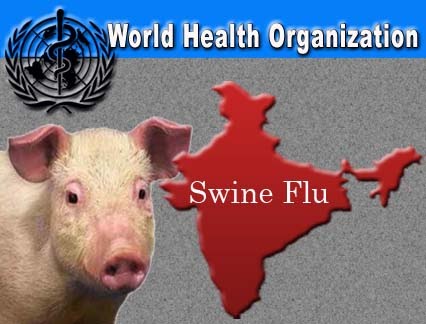World - 3500+
INDIA - 444+
Maharashtra-111+
Pune-59+
Mumbai-22+
Nashik-7
Aurangabad-2
Dhule-7
Latur-1
Karnataka-61
Gujrat-11+(Surat)
Tamilnadu-5
Chattishgarh-5
Delhi-11
Uttarakhand-3
Kerala-3
Goa-3
Rajasthan-3
Hariyana-3
Bengaluru - 7+
Saturday, September 19, 2009
Saturday, September 12, 2009
WHO recants H1N1 advice on schools
Almost six months after the bug made its presence felt, WHO has said closing schools at the start of an H1N1 flu outbreak could slow down the virus' spread by almost 30%-50% and help buy crucial time to build up defences against the highly infectious strain of influenza.
This is exactly what Indian schools, especially in Delhi and Pune, did. And interestingly, they did so against the Union health ministry's wishes. Following WHO's advice, the ministry had, for the past few months, been speaking of the lack of benefits in keeping entire schools shut after students tested positive for H1N1 infection.
The ministry's advice was to shut only those classes where a student had tested positive for H1N1. Health minister Ghulam Nabi Azad had held "shutting a school wouldn't mean you can stop students from attending parties and meeting friends in the evening where they can get the infection. Schools must stay open."
But on Saturday, WHO said experience to date has demonstrated the role of schools in amplifying transmission of the pandemic virus, both within and into the wider community. This has led to the revision of its opinion. After "drawing on recent experiences in several countries", WHO said school closure can operate as a proactive measure in reducing transmission of H1N1.
WHO said, "The main benefit of proactive school closure comes from slowing down the spread of an outbreak within a given area and thus flattening the peak of infections. School closure can also buy some time as countries intensify preparedness measures or build up supplies of vaccines and antiviral drugs."
WHO's modeling studies suggest school closure has its greatest benefits when this is effected very early in an outbreak. If schools close too late in the course of a community-wide outbreak, the resulting
reduction in transmission is likely to be very limited.
"The timing of school closure is critically important," WHO said. The H1N1 virus has killed at least 3,205 people worldwide since emerging last April in North America.
Despite the ministry's requests against school closure, TOI was the first to highlight an Imperial College, London, study that showed that closing down schools entirely during a flu pandemic may cut infection rates by 40%.
Mathematical models suggest that swine flu has an attack rate of 30% once it enters a country, that is, the likelihood is 30% of citizens will catch it at some point.
Children are thought to be important vectors of transmission and susceptible to most influenza strains than adults. High contact rates in schools also favour transmission.
WHO also highlighted that shutting down schools has a serious economic burden with cost arising from absenteeism of working parents or guardians who have to stay home to take care of their children.
Studies estimate that school closures can lead to the absence of 16% of the workforce.
WHO had earlier said that by the end of the pandemic, anywhere between 15% and 45% of a population would have been infected by the new pandemic virus. If one takes the mid-point figure of 30%, it'll mean two billion people getting the infection, WHO said.
This is exactly what Indian schools, especially in Delhi and Pune, did. And interestingly, they did so against the Union health ministry's wishes. Following WHO's advice, the ministry had, for the past few months, been speaking of the lack of benefits in keeping entire schools shut after students tested positive for H1N1 infection.
The ministry's advice was to shut only those classes where a student had tested positive for H1N1. Health minister Ghulam Nabi Azad had held "shutting a school wouldn't mean you can stop students from attending parties and meeting friends in the evening where they can get the infection. Schools must stay open."
But on Saturday, WHO said experience to date has demonstrated the role of schools in amplifying transmission of the pandemic virus, both within and into the wider community. This has led to the revision of its opinion. After "drawing on recent experiences in several countries", WHO said school closure can operate as a proactive measure in reducing transmission of H1N1.
WHO said, "The main benefit of proactive school closure comes from slowing down the spread of an outbreak within a given area and thus flattening the peak of infections. School closure can also buy some time as countries intensify preparedness measures or build up supplies of vaccines and antiviral drugs."
WHO's modeling studies suggest school closure has its greatest benefits when this is effected very early in an outbreak. If schools close too late in the course of a community-wide outbreak, the resulting
reduction in transmission is likely to be very limited.
"The timing of school closure is critically important," WHO said. The H1N1 virus has killed at least 3,205 people worldwide since emerging last April in North America.
Despite the ministry's requests against school closure, TOI was the first to highlight an Imperial College, London, study that showed that closing down schools entirely during a flu pandemic may cut infection rates by 40%.
Mathematical models suggest that swine flu has an attack rate of 30% once it enters a country, that is, the likelihood is 30% of citizens will catch it at some point.
Children are thought to be important vectors of transmission and susceptible to most influenza strains than adults. High contact rates in schools also favour transmission.
WHO also highlighted that shutting down schools has a serious economic burden with cost arising from absenteeism of working parents or guardians who have to stay home to take care of their children.
Studies estimate that school closures can lead to the absence of 16% of the workforce.
WHO had earlier said that by the end of the pandemic, anywhere between 15% and 45% of a population would have been infected by the new pandemic virus. If one takes the mid-point figure of 30%, it'll mean two billion people getting the infection, WHO said.
Wednesday, September 2, 2009
◆HOW DO yOU kNOW yOU HAVe INflUeNzA?
Seasonal Influenza:
• Fever
• Headache
• Aching muscles
• Exhaustion and feeling weak
• Loss of appetite
• Sore throat
• Runny or stuffy nose
• Dry cough
Pandemic Influenza:
While the first symptoms of pandemic influenza might be similar to seasonal flu symptoms, how the symptoms develop will depend on the nature of the specific virus. It is likely that most people will recover without needing medical attention, but the following symptoms may help you decide if you need to seek medical help:
• Shortness of breath while resting or doing very little work
• Persistent fever for 4 or 5 days
• Painful or difficult breathing
• Coughing up a lot of phlegm or bloody sputum
• Wheezing
• You are feeling better and then you develop a new fever or worsening c
ough with sputum
• You feel very drowsy and others have difficulty waking you up or note you seem confused or disorientated
• Fever
• Headache
• Aching muscles
• Exhaustion and feeling weak
• Loss of appetite
• Sore throat
• Runny or stuffy nose
• Dry cough
Pandemic Influenza:
While the first symptoms of pandemic influenza might be similar to seasonal flu symptoms, how the symptoms develop will depend on the nature of the specific virus. It is likely that most people will recover without needing medical attention, but the following symptoms may help you decide if you need to seek medical help:
• Shortness of breath while resting or doing very little work
• Persistent fever for 4 or 5 days
• Painful or difficult breathing
• Coughing up a lot of phlegm or bloody sputum
• Wheezing
• You are feeling better and then you develop a new fever or worsening c
ough with sputum
• You feel very drowsy and others have difficulty waking you up or note you seem confused or disorientated
◆ ResOURCes
Useful websites
United Nations: http://www.un.un.org/staff/pandemic
World Health Organization: http://www.who.int/csr/disease/swineflu/en.index.html
Centers for Disease Control and Prevention (CDC): http://www.cdc.gov.swineflu/investigation.htm Telephone
CDC Hotline: 1-800-CDC-INFO (1-800-232-4636) or 1-888-232-6348
7 days/24 hours. English and Spanish
India: www.swineflu.com
United Nations: http://www.un.un.org/staff/pandemic
World Health Organization: http://www.who.int/csr/disease/swineflu/en.index.html
Centers for Disease Control and Prevention (CDC): http://www.cdc.gov.swineflu/investigation.htm Telephone
CDC Hotline: 1-800-CDC-INFO (1-800-232-4636) or 1-888-232-6348
7 days/24 hours. English and Spanish
India: www.swineflu.com
◆ How to wear a mask:
If you choose to wear a mask, place it over your nose, mouth and chin and secure in place with either the strings or elastic bands provided. Adjust the metallic strip over the bridge of your nose to ensure a secure fit so that leaks are prevented. When removing the mask, do so by touching the straps only. Carefully place the face mask into a plastic bag and tie the bag closed before putting it into a rubbish bin, preferably one with a lid. Remember that masks cannot eliminate the possibility of infection.
◆ HOW DO yOU CARe fOR yOURself AND OTHeRs?
Caring for yourself
• Measure your temperature. If it is not above 38°C (100.4°F), you probably don’t have influenza.
• Rest and completely avoid rigorous exercise.
• Avoid contact with others.
• Stay at home.
• Drink plenty of fluids (a glass of water or juice every hour).
• Take paracetamol (also known as acetaminophen) to reduce fever and relieve pain. (It does not kill the virus, but it makes you feel better.)
• Gargle with warm water to ease a sore throat.
• Use saline (salt) solution nose drops to help relieve a stuffed nose.
• Keep your nose clean with disposable tissues and throw the used tissues in the garbage. Wash your hands afterwards.
• Don’t smoke
◆ Patients should not leave the home during the period when they are most likely to be infectious to others (i.e., 7 days from the onset of symptoms for adults or until 24-48 hours after resolution of symptoms, whichever is longer). When movement outside the home is necessary (e.g., for medical care), the patient should follow cough etiquette (i.e., cover the mouth and nose when coughing and sneezing) and wear a surgical mask if available.
Infection Control Measures in the Home
◆ All persons in the household should carefully follow recommendations for hand hygiene (i.e., hand washing with soap and water or use of an alcoholbased hand rub) after contact with an influenza patient or the environment in which care is provided.
◆ Although no studies have assessed the use of masks at home to decrease the spread of infection, use of surgical masks by the patient and/or caregiver during interactions may be of benefit. The wearing of gloves and gowns is not recommended for household members providing care in the home.
◆ Soiled dishes and eating utensils should be washed either in a dishwasher or by hand with warm water and soap. Separation of eating utensils for use by a patient with influenza is not necessary.
◆ Laundry can be washed in a standard washing machine with warm or cold water and detergent. It is not necessary to separate soiled linen and laundry used by a patient with influenza from other household laundry. Care should be used when handling soiled laundry (e.g., avoid “hugging” the laundry) to avoid contamination. Hand hygiene should be performed after handling soiled laundry.
◆ Tissues used by the ill patient should be placed in a bag and disposed with other household waste. Consider placing a bag for this purpose at the bedside.
◆ Normal cleaning of environmental surfaces in the home should be followed.
• Measure your temperature. If it is not above 38°C (100.4°F), you probably don’t have influenza.
• Rest and completely avoid rigorous exercise.
• Avoid contact with others.
• Stay at home.
• Drink plenty of fluids (a glass of water or juice every hour).
• Take paracetamol (also known as acetaminophen) to reduce fever and relieve pain. (It does not kill the virus, but it makes you feel better.)
• Gargle with warm water to ease a sore throat.
• Use saline (salt) solution nose drops to help relieve a stuffed nose.
• Keep your nose clean with disposable tissues and throw the used tissues in the garbage. Wash your hands afterwards.
• Don’t smoke
◆ Patients should not leave the home during the period when they are most likely to be infectious to others (i.e., 7 days from the onset of symptoms for adults or until 24-48 hours after resolution of symptoms, whichever is longer). When movement outside the home is necessary (e.g., for medical care), the patient should follow cough etiquette (i.e., cover the mouth and nose when coughing and sneezing) and wear a surgical mask if available.
Infection Control Measures in the Home
◆ All persons in the household should carefully follow recommendations for hand hygiene (i.e., hand washing with soap and water or use of an alcoholbased hand rub) after contact with an influenza patient or the environment in which care is provided.
◆ Although no studies have assessed the use of masks at home to decrease the spread of infection, use of surgical masks by the patient and/or caregiver during interactions may be of benefit. The wearing of gloves and gowns is not recommended for household members providing care in the home.
◆ Soiled dishes and eating utensils should be washed either in a dishwasher or by hand with warm water and soap. Separation of eating utensils for use by a patient with influenza is not necessary.
◆ Laundry can be washed in a standard washing machine with warm or cold water and detergent. It is not necessary to separate soiled linen and laundry used by a patient with influenza from other household laundry. Care should be used when handling soiled laundry (e.g., avoid “hugging” the laundry) to avoid contamination. Hand hygiene should be performed after handling soiled laundry.
◆ Tissues used by the ill patient should be placed in a bag and disposed with other household waste. Consider placing a bag for this purpose at the bedside.
◆ Normal cleaning of environmental surfaces in the home should be followed.
◆ HOW DO yOU ReDUCe yOUR RIsk Of CONTRACTINg INflUeNzA?
The practice of good personal hygiene is one of the most effective strategies any individual can implement to reduce their risk of being infected by the influenza virus. Important points are:
• Cover the nose and mouth with the sleeve when coughing or sneezing (not with the hand, as that contaminates the hand for touching and spreading organisms further);
• Use a tissue for cleaning/blowing the nose, and dispose of it after use;
• Clean your hands after coughing or sneezing, using a tissue, or touching any surface that may have become contaminated by a prior user. If using a surgical mask, dispose of it carefully after use and wash hands: ° Wash hands with soap and water (preferable) or clean with alcohol-based hand cleaner; ° When you wash your hands, wash for at least 20 seconds, making sure that all surfaces of hands and fingers are cleaned.
• Become “touch aware”, and avoid touching surfaces that are likely to have been touched by others (door handles, stair railings, etc)
• Avoid handshaking, social kissing, and other social rituals that involve touching others.
• Be careful with respiratory secretions when around other people (e.g. coughing and sneezing). If possible, avoid contact with individuals at risk (small children or those with underlying or chronic illnesses) until respiratory symptoms have resolved. For more information on personal hygiene measures, see:
• www.cdc.gov/flu/protect/habits/index.htm
• www.cdc.gov/cleanhands/
• Cover the nose and mouth with the sleeve when coughing or sneezing (not with the hand, as that contaminates the hand for touching and spreading organisms further);
• Use a tissue for cleaning/blowing the nose, and dispose of it after use;
• Clean your hands after coughing or sneezing, using a tissue, or touching any surface that may have become contaminated by a prior user. If using a surgical mask, dispose of it carefully after use and wash hands: ° Wash hands with soap and water (preferable) or clean with alcohol-based hand cleaner; ° When you wash your hands, wash for at least 20 seconds, making sure that all surfaces of hands and fingers are cleaned.
• Become “touch aware”, and avoid touching surfaces that are likely to have been touched by others (door handles, stair railings, etc)
• Avoid handshaking, social kissing, and other social rituals that involve touching others.
• Be careful with respiratory secretions when around other people (e.g. coughing and sneezing). If possible, avoid contact with individuals at risk (small children or those with underlying or chronic illnesses) until respiratory symptoms have resolved. For more information on personal hygiene measures, see:
• www.cdc.gov/flu/protect/habits/index.htm
• www.cdc.gov/cleanhands/
◆ Precaution
Wash your hands frequently every day with soap and warm water for 15-20 seconds; especially before meals, or each time after touching a surface that you suspect could be contaminated with flu virus such as a door handle or a knob/handle, especially if you have returned from a public place or used public transport. Alcohol-based hand cleaners should be kept handy at all times and used until you can get soap and warm water.
Remedy No.6
Have citrus fruits, particularly Vitamin C rich Amla (Indian gooseberry) juice. Since fresh Amla is not yet available in the market (not for another three to four months), it is not a bad idea to buy packaged Amla juice which is commonly available nowadays.
Remedy No.5
Aloe vera (gwarpatha) too is a commonly available plant. Its thick and long, cactus-like leaves have an odourless gel. A teaspoon gel taken with water daily can work wonders for not only your skin and joint pains, but also boost immunity.
Tuesday, September 1, 2009
Subscribe to:
Posts (Atom)




